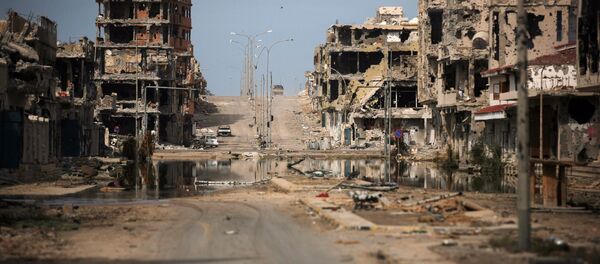Anti-government protests began on February 15 in Benghazi, the second-largest city in Libya. Demonstrators demanded the release of lawyer and rights activist Fethi Tarbel. When Tarbel was released, the protestors did not disperse but clashed with the police. After that, security forces dispersed several hundred demonstrators who chanted anti-regime slogans. According to Libyan media reports, 14 people were injured in the clashes. By late February, Benghazi passed under the control of Gaddafi opponents. A national council was formed in the city as a revolutionary body whose authority was to be recognized by all cities that had supported the Libyan leader’s opponents. Protests by regime opponents also began in the country’s capital Tripoli. According to international organizations, the authorities relentlessly cracked down on demonstrators.
On February 26, the UN Security Council adopted a resolution introducing international sanctions against the Libyan leadership. The sanctions, designed to stop the killings of regime opponents, provided for an embargo on arms trade with Libya, the freezing of accounts and a ban on trips abroad by the Libyan leader, his family members and his close associates.
By that time, Gaddafi had almost completely lost control over the eastern part of the country.
On February 27, the Libyan opposition announced the establishment of the National Transitional Council as an interim government, and preparations for a presidential election.
On March 17, the United States and its Western partners initiated a UN Security Council resolution introducing a no-fly zone over Libya. Russia and China did not exercise their veto power, believing that the zone was not in conflict with the international community’s efforts to settle the situation in the country. However, in reality, forces of the NATO-led Western coalition exceeded the UN mandate and began delivering airstrikes on the country’s state, civilian and military installations, thus siding with the insurgents.
On March 19, a foreign military operation against the Gaddafi regime began in Libya with the participation of UK, French, US, Canadian, Belgian, Italian, Spanish and Danish armed forces. French combat aircraft that took off from the Saint-Dizier airbase delivered the first airstrike against Libyan military facilities near Benghazi. On March 31, command of the Libya campaign passed completely to NATO. The armed uprising in Libya lasted about nine months. As a result, Jamahiriya leader Muammar Gaddafi was overthrown and on October 20, 2011 killed near his hometown of Sirte, where he was hiding from his opponents.
The oil-producing country suffered enormous economic damage. Precise casualty figures are still unknown. According to official Libyan statistics, 5,500 people were killed in several months of 2011.
On October 23, 2011, the National Transitional Council officially announced the end of the civil war in Libya.
The NATO operation in Libya ended on October 31, 2011.
After Gaddafi’s death, the struggle for power began between various clans and armed groups both at the national and regional level.
On July 7, 2012, parliamentary elections to the General National Congress took place in Libya. The majority of seats went to two competing parties: the National Forces Alliance and the Islamist Justice and Construction Party. The confrontation between the Islamists and moderate forces with support from a segment of the military establishment led to another armed conflict, as a result of which a dual power situation evolved in August 2014. The House of Representatives, recognized by the international community, was based in the city of Tobruk in the east of the country, while the pro-Islamic General National Congress (GNC), which was supported by armed groups, was based in Tripoli. Militia groups that supported the GNC fought incessantly with supporters of a secular development model from Tobruk. In the south, there were constant clashes between tribes, some of which sided with Tobruk and some with Tripoli.
After the overthrow of Gaddafi, members of ISIS (Islamic State, IS) and al-Qaeda (organizations banned in Russia) moved into Libya on a massive scale, teaming up with local terrorist groups and posing a great threat to the very existence of the state.
The international community supported the political process aimed at the formation of a national unity government.
On December 17, 2015, the UN-brokered Libyan Political Agreement was signed in Skhirat, Morocco.
The main point of the agreement, which took the parties to the conflict 14 months to coordinate, was the formation of an interim Government of National Accord, with a view to holding new parliamentary elections within two years.
On December 23, 2015, the UN Security Council passed Resolution 2259 approving the December 17 agreement on the formation of the Government of National Accord. The resolution was unanimously approved by 15 members of the UN Security Council.
On March 31, 2016, the Government of National Accord was formed in Tripoli, led by Prime Minister Fayez al Sarraj.
Islamists from the now defunct GNC joined the High Council of State, a parallel parliament, which, under the UN plan, should perform advisory functions.
The Tobruk parliament did not support the Government of National Accord, rejecting a vote of confidence in the UN-backed government.






